Response Spectrum Load Cases
| ||||
|
| ||||
|
| ||||
|
Enter the load cases, spectrum functions and loading directions for response spectrum analysis.
The procedure for response spectrum analysis in midas Gen is outlined below.
1. Enter mass data using various ways provided in the Main Menu, Model>Masses.
2. Enter the number of modes and necessary data for eigenvalue analysis in Eigenvalue Analysis Control.
3. Define spectrum data to be applied in Response Spectrum Functions.
4. Set options related to response spectrum analysis in Response Spectrum Load Cases.
5. Perform analysis by clicking Perform Analysis or using the Main Menu, Analysis>Perform Analysis.
6. When an analysis is completed, analyze the results using load cases or load combinations with various post-processing functions from the Results menu. | ||||
|
| ||||
|
| ||||
|
| ||||
|
From the Main Menu select Load > Response Spectrum Analysis Data > Response Spectrum Load Cases.
Select Response Spectrum Analysis > Response Spectrum Load Cases in the Menu tab of the Tree Menu. | ||||
|
| ||||
|
| ||||
Modal Combination Control Enter the method of mode combination and specify whether to restore the signs of response spectrum analysis results. MIDAS/Gen allows the user to select the modes for a modal combination so that the major modes of a structure can be combined. [Details...]
Spectrum Functions
Select pre-defined design spectrum functions, which will be used to define a number of response spectrum load cases. A same spectrum from a code may result in a number of spectrum functions depending on the damping ratio. Therefore, this becomes useful when the user wishes to define a number of spectrum functions based on different damping values in a structure.
Function Name Select a spectrum function name. If spectral
functions have not been defined, click the Input Data
1. Select a number of spectrums in Spectrum Functions list. Spectrum Function is defined in Response Spectrum Function.
Note In case a single spectrum is selected, Damping Ratios for each mode are not calculated, and an identical Damping Ratio is applied to all the modes.
2. Check on "Apply Damping Method" and select Damping Method. Default is Modal.
3. Check if Interpolation of Spectral Data is selected. Default is Logarithm.
Application Principles
1. Calculation is carried out by the interpolation of spectrum data applied by the Damping Ratios corresponding to modes.
2. If the calculated values deviate from the range of the maximum and minimum values of the selected spectrum, the maximum or minimum value of the spectrum will be applied.
3. If the calculated values exist in the range of the maximum and minimum values of the spectrum selected with a damping ratio for a mode, modal spectrum is internally generated for the mode by interpolation of spectrum data.
Procedure for Interpolation of Spectrum
Select multiple spectrums defined in Spectrum Function and calculate the Damping Ratios for each mode according to the selected method in Apply Damping Method of Response Spectrum Load Cases after which spectrum data for each mode is generated.
Example
In case "Damping Method = Modal", the method of generating spectrums by modes on the basis of the figure above is outlined below.
1. Mode 1: The user specified Damping Ratio=0.01 is greater than the maximum spectrum with 0.02. So the spectrum with the damping ratio of 0.02 is created.
2. Mode 2: Spectrum with the damping ratio of 0.05 defined in Spectrum Function is directly used without any interpolation.
3. Mode 3: The user specified Damping Ratio=0.07 is within the damping ratios 0.05 ~ 0.10. The spectrum with the damping ratio of 0.07 is generated by the interpolation of the spectrum data.
4. Mode 4:. Spectrum with the damping ratio of 0.10 defined in Spectrum Function is directly used without any interpolation.
5. Mode 5: The user specified Damping Ratio=0.15 is less than the minimum spectrum with 0.10. So the spectrum with the damping ratio of 0.10 is created.
Note In case of Mass & Stiffness Proportional Damping and Strain Energy Proportional Damping, damping ratio for each mode is automatically calculated, which is then used to generate the spectrum data by modes in the same manner as above. If Strain Energy Prop. is used to calculate damping ratios, the "Calculate Only When Used" option needs to be checked off at the lower part of the Model > Property > Group Damping dialog box.
Input Data
1. Select a single spectrum from the Spectrum Functions of Response Spectrum Load Cases.
Note When the user selects multiple spectrum functions, the Correction equation is not applicable since spectrum functions are generated by interpolation of spectrum data based on damping ratios.
2. Check on “Apply Damping Method” and “Correction by Damping Ratio”.
3. Check to see Interpolation of Spectral Data is selected. Default is Logarithm.
Note In case a single spectrum is selected, Interpolation of Spectral Data will not be used since modal damping ratios are calculated by modes by the method below.
Application Principles
1. 1. Calculate damping ratios for each mode.
2. 2. The equation calculated here is applicable only for a spectrum with the damping ratio of 0.05. So it cannot be used for other spectrums with different damping ratios.
Procedure for Spectral Data Correction
As shown in the figure below, damping ratios by modes are obtained and spectral data is generated, using the Spectrum Function (Damping Ratio = 0.05).
Note When the user calculates damping ratios using Strain Energy Proportional Damping, the "Calculate Only When Used" option needs to be checked off at the bottom of the Group Damping dialog from the main menu, Model > Property > Group Damping. Apply Damping Method
Damping Method : Define the damping property of a structure using multiple design spectrums. User defines the damping ratio for each mode, and the modal response will be calculated based on the spectrum function, which is modified by the user defined damping ratio.
Direct Specification of Modal Damping: Specify the damping ratio for each mode directly.
Damping Ratio for All Modes: It applies to every mode except the ones that user has directly specified. It applies to all the modes other than the damping ratios assigned to specific modes in the Modal Damping Overrides table below. When the entered damping ratio is different from the user specified damping ratio in Response Spectrum Functions, the previous spectrum data will be interpolated based on this damping ratio.
Modal Damping Overrides: User directly defines the damping ratio for each mode.
Mode: Mode Number
Damping Ratio: Damping ratio for each mode
• Mass and Stiffness Proportional Using the dynamic property and the modal damping ratios of two modes, the damping matrix which is proportional to Mass and Stiffness is generated. This damping matrix evaluates the damping ratio for each mode, and the response spectrum analysis is carried out while reflecting the modal damping ratio.
Mass and Stiffness Proportional
Damping Type: Select if the damping matrix is proportional to Mass or to Stiffness.
Direct Specification: User directly defines the proportional coefficients for the checked Damping Type.
Calc. from Modal Damping: Using the modal damping ratios that the user specified, it automatically calculates and inputs the proportional coefficients.
Coefficients Calculation: If either Mass or Stiffness proportional is checked in Damping Type, modal damping ratio of only one mode can be entered. If both are checked, modal damping ratios for two modes will be specified.
Frequency[Hz]: Enter the frequency of the corresponding mode to be assigned a damping ratio for calculating proportional coefficients.
Period [Sec]: Enter the period of the corresponding mode to be assigned a damping ratio for calculating proportional coefficients.
Damping Ratio: Enter the damping ratio corresponding to the specified frequency or the period.
User evaluates the modal damping ratio according to the damping ratio user-defined in Group Damping. The result modifies the spectrum function and calculates the response.
When element damping by members and boundaries defined in Group Damping is used, the damping matrices of most structures become a non-classical damping type, which can not be separated by modes. Therefore, in order to reflect the damping property of each element in dynamic analysis, modal damping ratio is calculated on the basis of the strain energy concept.
Correction by Damping Ratio : When a single spectrum is selected, a modifying equation is used to adjust the spectrum to apply to each mode having
Note
1
Note
2
Interpolation of Spectral Data
Select the method of interpolating the response spectrum load data.
Linear : Linear interpolation method
Logarithm : Log-scale interpolation method
Accidental Eccentricity
Select whether to include accidental eccentricity moments in the calculation
of response spectrum loads. Click
Note
1
Note
2
Note
3
Accidental Eccentricity for Response Spectrum Load dialog box
Eccentricity Data
Automatic An eccentricity in terms of a percentage of plan dimensions is automatically considered.
User Defined The user defines the eccentricities individually.
Revision of Gen 2010
Consider Eccentricity below G.L
Check on: Eccentricity is considered for both above-ground and underground floors.
Check off: Eccentricity is considered only for above-ground floors.
Description
Enter a brief description.
Operations
Enter new or additional response spectrum analysis load cases
Enter the above entries and click
Modify previously entered response spectrum analysis load cases
Select a response spectrum analysis load
case from the list in the dialog box and click
Delete previously entered response spectrum analysis load cases
Select a response spectrum analysis load
case from the list in the dialog box and click
In addition to the spectrum functions and the loading conditions of the response spectrum, access the following functions to enter additional data required for a response spectrum analysis:
| ||||
|
|

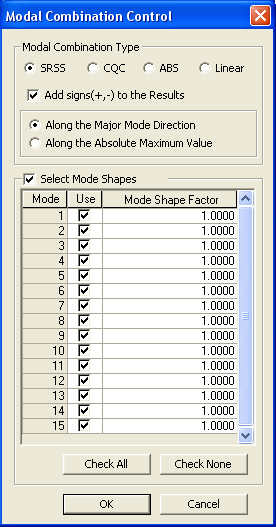
 : the
representative maximum value for a particular response
: the
representative maximum value for a particular response  :
the peak value of the particular response for the i-th mode
:
the peak value of the particular response for the i-th mode :
the ratio of the natural frequency of the i-th mode to that of the j-th
mode
:
the ratio of the natural frequency of the i-th mode to that of the j-th
mode :
damping ratio
:
damping ratio

 button located
at the bottom of the dialog box to define spectrums. (Refer to "
button located
at the bottom of the dialog box to define spectrums. (Refer to "

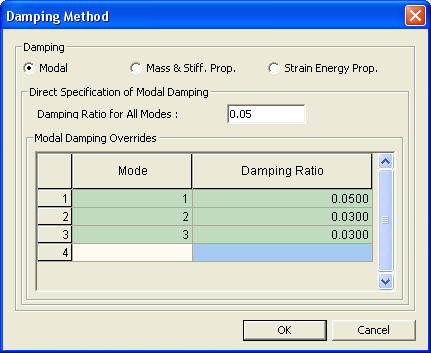

 : to modify the existing
damping ratio
: to modify the existing
damping ratio : to remove the existing
damping ratio
: to remove the existing
damping ratio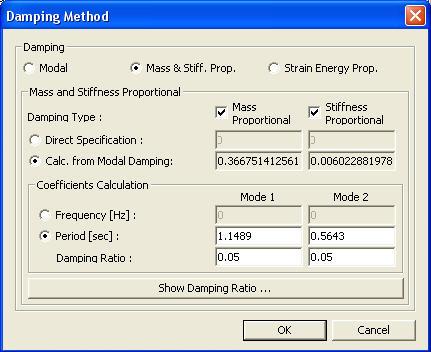

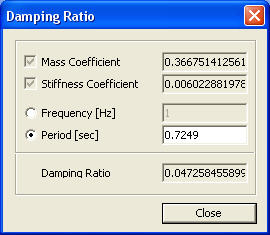
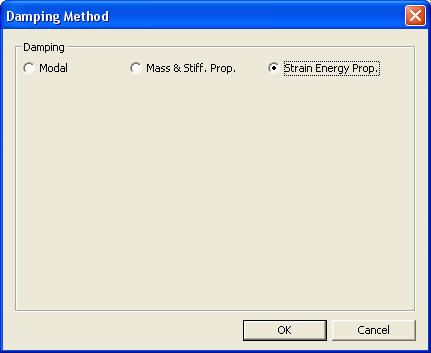

 to prompt the Accidental
Eccentricity for Response Spectrum Load dialog box.
to prompt the Accidental
Eccentricity for Response Spectrum Load dialog box.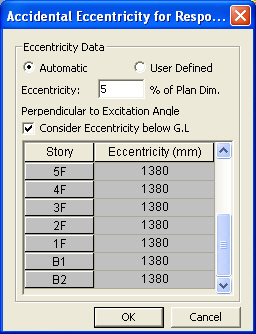
 .
. .
.
